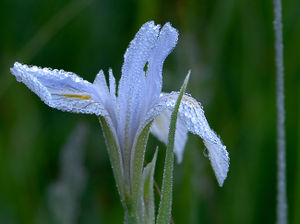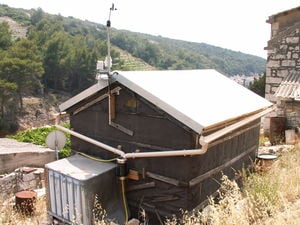Introduction
As the world’s population increases, fresh water supplies are being tapped out. Desalinization has become a necessary means of acquiring water; however current methods are usually quite costly and use fossil fuels. This is inappropriate for the developing world, where there is a serious need for increased fresh water availability. Atmospheric water vapor processing (AWVP) is a new and emerging technology in which the atmospheric water vapor is condensed and collected.[1][2][3]
Opperating Principle
There is approximately 4 g of water vapor per cubic metre of air in the earths atmosphere. This source of potable water is available virtually worldwide. AWVPs harvest this water, by condensing it from vapor to liquid.[4][5]
Advantages
- It is at an early stage in development, but has the potential to provide environmentally acceptable alternatives to standard water supplies.[4][5]
- Many AWVP designs favor decentralization of water distribution and avoidance of huge capital costs for infrastructure.[5]
- AWVP can be made appropriate, community-managed and community-maintained for developing countries.[5]
- AWVP methods are competitive with desalination plants and simpler and less expensive to operate and maintain.[5]
- The amount of water produced would vary according to installation size, and be suitable to provide potable water to individuals or even thousands of people.[5]
- AWVP production can take place in a wide variety of locations. Thus, expensive water distribution infrastructure can be reduced or avoided.[5]
- Chemically, water vapor in the atmosphere is as clean as the air around it. Naturally occuring dew is a potable source of soft water, generally low on any mineral content.[6]
Disadvantages
Types of AWVPs
Currently, there are three main methods of taking moisture of air.[5]
Cooled surface condensors
A surface is either cooled via a heatpump or refrigeration cycle, or with radiative cooling.
Radiative Cooling

Interestingly, many desert and costal plants and animals depend on this source.[7] Naturally, the phenomenon of dew formation takes place due to night sky radiation cooling. On a clear night, heat energy is radiated away from the earth’s surface into the sky. As the surface temperature drops below the dew point, water vapor will condense into droplets. Dew is formed both from water vapor in the atmosphere in the form of dewfall, as well as from water in the soil in the form of dewrise. [8][9]
The amount of dewfall can be approximated from a complex turbulent fluid analysis; however it is far simpler to consider it as an energy balance problem.[9] Note that the process of condensation releases energy.
Where
- R = net incoming radiation flux (a negative term)
- G = flux of total heat from soil to surface
- C = flux of sensible heat from air to surface
- F = flux of water vapor from air to surface
- λ = latent heat of vaporization
- Q = heat capacity of the air-grass layer per cm2
- T = mean temperature of layer
- M = heat released by vegetable metablism per cm2
Furthermore, it follows that the maximum possible condensation rate for combined dewfall and dew-rise during nighttime is:[10][11][12][8]
Where
- Df = rate of dewfall in
- Dr = rate of dew rise in
- s = slope saturation curve in
- Q* = net radiation in
- γ = psychrometric constant
- λ = latent energy for vaporization in
Studies have demonstrated that the above modle can accurately and reliably predict dew rates.[8] Therefore, it is useful to quickly determine the seasonal dewfall of an area based on data from meteorological archives.
The maximum amount of dewfall possible on a given night is limited by the amount of radiative cooling possible, and is estimated to be approximately 1 mm. [11][13] In actuality, this number is usually much lower, ranging from 0.17 – 0.45 mm per night.[12]
Recent research has found materials that produce a higher dew yield. Materials that exhibit a large amount of radiative cooling will condense more dew, and hydrophylic materials will make dew collection easier. Specifically, TiO2 and BaSO4 microspheres embedded polyethlene resulted in a 20% increase of dew yield compared to Plexiglas.[14]
The angle of the surface is also important. The optimal angle has been determined through numerical models and experimental testing to be 30o from horizontal. A flatter surface will radiate more energy, however a steeper surface has improved dew collection characteristics.[14]
Unfortunately, bacterial concentrations in Dew water have been seen to exceed World Health Organization limits on various occasions. Therefore, it will require disinfectant to be considered potable.
Collecting Dew from Rooftops
Naturally forming dew is the most readily available way to obtain liquid water from the atmospheric vapor.
In certain climates, a significant amount of dew naturally forms on roofs. Just by collecting this dew, the average family sized roof can collect over 2L of potable water per night that dew forms.[1]
Design
The steepness of the roof is an important criterion. 30o from the horizontal is optimal.[14][15]
The peak of the roof should be aligned co-linearly with the direction of the prevailing wind. This will ensure that the wind flows evenly over the entire roof surface. If the roof peak is perpindicular to the prevailing wind, there will be increased turbulence, and leeward roof side will be negatively impacted.
Gutters are installed along the perimeter of the low end of the roof surface. They should be angled downward at
Construction

It is best to build a roof with dew collection in mind. The roof shape, slope, direction of slant, and material are all considerations. Specifically, roofs made out of plastic or galvinized iron . This article is written for those
Materials
Tools
Skills and Knowledge
Estimated Costs
Case Studies
This study then investigates the extent to which existing roofs, without any modifications except for roof gutters and a collection tank, can collect a substantial amount of dew water. This is the first time that such work is done in India and meteorological data analyses is required to assist in a large-scale dew feasibility study.
The study site is Kothara, India ( 23°14N, λ 68°45E, at 21 m a.s.l.) situated within 20 km from the Arabian Sea on a gulf. It is located in the Rann of Kutch area and near the city of Bhuj, in the Gujarat state. The location is typical of rural north-western India. Annual average rainfall is low (300 mm) and very erratic—the coefficient of variation is 75%. Annual pan evaporation is 2000 mm thus the area is extremely arid.
Most of the population relies on drinking water drawn from open wells. The population pressure is such that the level of the phreatic aquifer is constantly receding. In addition, salt water is now entering the phreatic zone. Water level in the well in Kothara is now 60 m from ground level and the amount available is very small.
Dew is abundant in this area during 8–9 months of the year (from late September to early May). During the remaining months, the monsoon season makes the sky cloudy and dew does not form. It is in this season that some rain occurs but with the number of rainy days as few as 5 or less.
There are many buildings in Kutch that use corrugated galvanized iron (GI) sheets for roofing—hay warehouses, factory sheds, cattle barns, and occasionally schools. Some condensation is visible over these roofs in the season. It was decided therefore to make systematic measurements on a plain, uninsulated, corrugated GI test roof so as to determine the dew water quantity and frequency and check if the quantity is significant for practical use.
Two sloping surfaces were erected on a triangular framed support. The ridge is oriented north–south and is 4 m from the ground. The roofing sheet is made of commercially available corrugated GI 1.5 mm thick. The sheet was new with a shiny surface and the IR emissivity was measured as 0.23. Over time, these sheets become dull with a slight increase in emissivity to 0.3 after many years. The roof was not insulated.
The roof slope is 30° with the left-half (9 m2 area) facing west and the right-half (9 m2 area) facing east. There were separate gutter and collection cylinders installed for each side. The collected water was measured at about 08:00 local time (UT+06:30) each day for one entire season (October 1, 2004–May 31, 2005). The volume of water is measured in graduated glass vessels with accuracy ±5 mL.
Air temperature and relative humidity, windspeed (three cups anemometer at 5 m above the ground) were measured and recorded on site every hour by a data logger (Weather Technologies India). Temperature measurements accuracy is ±0.2 °C (resolution ±0.1 °C), relative humidity accuracy is ±3% (resolution ±0.1%), windspeed accuracy is better than ±0.5 m s−1 with a stalling speed of 0.3 m s−1. Cloud cover observations were obtained from the Indian Meteorological Observatory, Naliya, 10 km northwest of Kothara.
Wind direction data used here was obtained from a weather station (Weather Technologies) at Suthri, 15 km southwest of Kothara. Wind direction measurements are within ±3° accuracy with a resolution of 1° and a starting threshold at most 0.5 m s−1. This sensor was also placed 5 m above the ground. Records are for the period November 1, 2004–May 31, 2005. The terrain between the two sites and in the neighbourhood is flat with no topographical undulations and nearly bare of vegetation. Thus the wind direction in Kothara was taken to be the same as in Suthri.
Total dew collected: 113.5L Number of dew days: 74
Vapor concentrating dessicants
Engineering Principles
Controled induced convection
Engineering Principles
Dew Formation
References
- ↑ 1.0 1.1 Sharan, G., 2006, "Dew harvest: to supplement drinking water sources in arid coastal belt of Kutch," Foundation Books, .
- ↑ Rajvanshi, A. K., 1981, "Large Scale Dew Collection as a Source of Fresh Water Supply," Desalination, 36(3) pp. 299-306.
- ↑ Habeebullah, B. A., 2009, "Potential use of Evaporator Coils for Water Extraction in Hot and Humid Areas," Desalination, 237(1-3) pp. 330-345.
- ↑ 4.0 4.1 Wahlgren, R., 1993, "Atmospheric Water Vapour Processing," Waterlines, 12(2) pp. 20-22.
- ↑ 5.0 5.1 5.2 5.3 5.4 5.5 5.6 5.7 Wahlgren, R. V., 2001, "Atmospheric Water Vapour Processor Designs for Potable Water Production: A Review," Water Research, 35(1) pp. 1-22.
- ↑ Beysens, D., Muselli, M., Mileta, M., 2004, "Is dew water potable? Physical, Chemical and Biological Characteristics of Dew on Atlantic Coast (Bordeaux, France), Mediterranean Coast (Zadar, Croatia) and Mediterranean Island (Ajaccio, Corsica Island, France)," Proceedings: Third International Conference on Fog, Fog Collection and Dew, Cape Town, South Africa, October, Anonymous pp. 11-15.
- ↑ Uwe G., 1979, “In the Deserts of this Earth”, Harcourt Brace Jovanovich Inc.
- ↑ 8.0 8.1 8.2 Jacobs, A. F. G., Van Boxel, J. H., and Nieveen, J., 1996, "Nighttime Exchange Processes Near the Soil Surface of a Maize Canopy," Agricultural and Forest Meteorology, 82(1-4) pp. 155-169.
- ↑ 9.0 9.1 9.2 Monteith, J. L., 2007, "Dew," Quarterly Journal of the Royal Meteorological Society, 83(357) pp. 322-341.
- ↑ Monteith, J. L., 1981, "Evaporation and Surface Temperature," Quarterly Journal of the Royal Meteorological Society, 107pp. 1-27.
- ↑ 11.0 11.1 Jacobs, A. F. G., Heusinkveld, B. G., and Berkowicz, S. M., 2002, "A Simple Model for Potential Dewfall in an Arid Region," Atmospheric Research, 64(1-4) pp. 285-295.
- ↑ 12.0 12.1 Garratt, J. R., and Segal, M., 1988, "On the Contribution of Atmospheric Moisture to Dew Formation," Boundary-Layer Meteorology, 45(3) pp. 209-236.
- ↑ Jacobs, A. F. G., Van Pul, W. A. J., and Van Dijken, A., 1990, "Similarity Moisture Dew Profiles within a Corn Canopy," J.Appl.Meteorol, 29pp. 1300–1306.
- ↑ 14.0 14.1 14.2 Beysens, D., Milimouk, I., Nikolayev, V., 2003, "Using Radiative Cooling to Condense Atmospheric Vapor: A Study to Improve Water Yield," Journal of Hydrology, 276(1-4) pp. 1-11.
- ↑ Sharan, G., Beysens, D., and Milimouk-Melnytchouk, I., 2007, "A Study of Dew Water Yields on Galvanized Iron Roofs in Kothara (North-West India)," Journal of Arid Environments, 69(2) pp. 259-269.





